System Overview
Getting Started
New to CaliberMind - Start Here!
How do I use CaliberMind's search functionality?
Company or Account Detail - Search Results
Campaign Detail - Search Results
Person Detail - Search Results
Opportunity Detail - Search Results
How Does CaliberMind Define a "Channel"?
What Is a CaliberMind Event or Event Table?
How to use Dashboards
CaliberMind Home Page - Updated
Quick Link Bookmarks
Connectors / Integrations
CaliberMind Connectors - Start Here!
Adding Your First Connector
CaliberMind Connectors
How to Connect: Act-On
How To Connect: AdRoll / RollWorks
How to Connect: G2, Bombora, or 6sense
How to Connect: Google Ads [via FiveTran]
How To Connect: Google Analytics
How to Connect: Google Sheets
How To Connect: HubSpot
How to Connect: Klaviyo [via FiveTran]
How To Connect: LinkedIn Ads
How To Connect: Marketo
How To Connect: Microsoft Dynamics
How To Connect: Outreach
How to Connect: Pardot [via FiveTran]
How to Connect: Salesforce [via FiveTran]
How to Connect: Segment [via FiveTran]
How to Connect: Twitter [via FiveTran]
How to Connect: ZoomInfo / DiscoverOrg
How To Connect: Google Campaign Manager 360
Kickfire
Setting Up the LinkedIn Push Connector
Setting Up the Salesforce Push Connector
How to Connect: Slack
Power BI/ Tableau/ Looker Connectors Article
Connecting Your Data Warehouse to CaliberMind - Start Here!
Connecting Tableau to CaliberMind
CaliberMind Data Export to Google Cloud Storage
Ingesting CaliberMind Data Into Snowflake
Pushing CaliberMind Person Engagement Data to Salesforce
Integrations Appendix by Connector
SFTP Connector - Updated 2021
Replicating CaliberMind Attribution Data to Salesforce
How to Connect Facebook Ads
How To Connect: Google Search Ads 360
KickFire De-Anonymization in CaliberMind
Field History SFDC Limits (Salesforce)
SFTP Synced Files - Making a Data Change
Connections - Email Notifications
CaliberMind Data Access FAQs
Microsoft Bing Connector [via FiveTran]
Connector Health and Web Tracker Health reports
Connectors Status Page
In-App Notifications
CaliberMind IP Addresses for Whitelisting
Developer Guide
Developer Guide - Start Here!
CaliberMind Entity Relations and System Tables
What is Google BigQuery
CaliberMind Common Data Sources
CaliberMind Identity Levels
System Configuration
Configuring Funnels
How to Set Up and Configure Funnels
Funnel Stages Configuration and Stage Definitions
Funnels FAQs Technical Documentation
Funnel Company Inclusion Configuration
Event Explore for Funnels
Funnel History Event Configuration
Funnel Static Event Configuration
Funnel Person Inclusion Configuration
Funnel Person Status Exits
Object Manager: Campaign Member
How to See Your Object Manager History and Revert Back to Previous Versions
Setting Your Saved Filters for In-App Reporting
Setting Up UTM Mapping in CaliberMind
UTM Parameters Formatting and Best Practices
Standard Channel Logic
Channel Ranking Logic
Custom SQL Data Transformations
Add BigQuery Users within CaliberMind
Remove a BigQuery User within CaliberMind
Adding Custom Columns in Salesforce
How to Email CaliberMind Reports
Setting Up Account Trend Emails
How does CaliberMind normalize the raw data for use?
List Builder
List Builder - Start Here!
What are Lists?
Creating a List Using the List Builder - Step-by-Step Instructions
Use Case Videos - Creating a List Using the List Builder
Importing a List
Downloading a List - Step-by-Step Instructions
Account List Upload - File Requirements
People List Upload - File Requirements
Campaign List Upload - File Requirements
Creating an Account List From a Campaign
Creating Company Lists in List Builder
Creating Company Lists using SQL
How to create a list of all Opportunities that have a very low Engagement
Where is my Segments Menu?
Keyboard Shortcuts using SQL
Web Tracker Installation & Settings
Web Tracker and Installation Settings - Start Here!
Installing AnalyticsJS (CaliberMind snippet)
Two ways to identify prospects that submit a form containing email address using AnalyticsJS
Install AnalyticsJS on a HubSpot website
Using AnalyticsJS Identify on embedded Hubspot forms
Using AnalyticsJS Identify on embedded Marketo forms
Types of Analytics.js Calls
Analytics.JS Overview
Using Analytics.js to Track Web and Product Events
How Cookie Settings Affect the Analytics.JS Tracking Script
Google Tag Manager (GTM) Ad Blockers
Using AnalyticsJS with Drift
Using AnalyticsJS with Qualified
How to check your AnalyticsJS implementation
Identify users using Intercom Messenger
Flows
CaliberMind's Most Popular Flows | Automations
How to use QuickFlows
Flows Status Page
Merge records in Salesforce CRM
Add a Quick-Flow to Salesforce Campaign
Using ClearBit Flows
Setting Up Workflow - Lead Deduplication
ZoomInfo - Add-to/Enrich your database
Setting Up Workflow - Website Repair
Setting Up Workflow - Account Deduplication
Creating Sales Campaigns from Salesloft and Outreach Activities
Setting Up Workflow - Contact Deduplication
Campaigns
Campaigns - Start Here!
Custom Programs for Campaigns
Campaign-Program Membership
Custom Campaigns
Program Logic for Campaigns
Setting Up Answers
Setting Up Answers - Start Here!
Using CaliberMind Answers to Understand Campaign Performance
Using CaliberMind Answers to Understand Account Engagement
Using CaliberMind Answers to Understand Funnel Performance
Using CaliberMind Answers to Understand Funnel Impact
Using CaliberMind Answers to Understand Funnel Flow
Ask Cal Custom AI Answer
Ask Cal Custom Answers: Use Cases
User Administration & SSO
Administration and SSO - Start Here!
Single Sign On (SSO) Setup
Manage Users - Viewing, Inviting, Updating Users and Roles
User Authentication and Provisioning
CaliberMind Data Warehouse Access in Google BigQuery
CaliberMind Insights Dashboards
Working in Insights
CaliberMind Insights - Browser Requirements
CaliberMind Insights - Sharing Dashboards & User Permissions
CaliberMind Insights - Navigating to Insights/Dashboard
CaliberMind Insights - Using Dashboards
CaliberMind Insights - Dashboard Refresh Schedule
CaliberMind Insights - Application Concepts and Terminology
CaliberMind Insights - Filters & Aggregation Type
Building Dashboards - Insights
Attribution Dashboards - Insights
Insights - Attribution - Start Here!
Insights - Attribution Terminology and Key Concepts
Insights - Attribution Overview Dashboard 2.0
Engagement Dashboards - Insights
Insights - Engagement - Start Here!
Insights - Engagement - Dashboard Terminology & Key Concepts
Insights - Engagement Overview
Insights - Engagement - System Account Detail
Insights - Engagement - Person Detail
Build Insights Dashboards - Start Here!
Creating a Custom Pipeline Dashboard (VIDEO)
CaliberMind Insights - Creating Custom Dashboards
Build Your Own Insights Pipeline Dashboard
Building Formulas with Functions
Insights - ROAS Dashboard Use Cases
Creating and Editing a Widget Formula
Using Conditional Statements
How is CaliberMind ROAS Reporting Different than Insights ROI?
Insights - ROI - Start Here!
How to Create a Filter Bookmark
Create Date Range Filters - Step-by-Step
Creating Formulas Based on Criteria and Conditions (Filters)
Insights Data Connector Health Dashboard
Dashboard Function Reference
Introduction to Formulas - Start Here!
Insights Web Tracker Health Dashboard
Using Quick Functions
Insights - ROAS Terminology & Key Concepts
Insights Engagement Dashboard - Aggregation Dates
Filters
Object Mapping for Filters - Start Here!
Custom Configuration for Object Mapping
Object Mapping Filters
How to Map Your Salesforce Opportunity Revenue Field
Object Mapping: Create a Filter
Object Mapping: Create a Mapping
Object Mapping: Create a Replacement
Object Mapping: Create a Campaign Substitution
Filters Update for Creating Filter Sets
Filter Drawer Definitions
CaliberMind Sandbox
GDPR Compliance with CaliberMind
Data Dictionary
Attribution
Analytics
Attribution
Attribution Overview: Summary Tab
Attribution Overview: Comparisons Tab
Attribution Overview: Explore Tab
Attribution Overview: Opps Tab
Attribution Overview: People Tab
Attribution Overview: Events Tab
Campaign Types: Best Practices for Easy-to-Read Attribution
Virtual Campaigns in CaliberMind
Attribution - CaliberMind versus Embedded Attribution in Salesforce?
Removal effect with a Markov chain model
Attribution Reports Summary
Demand Generation
Data Integrity
Customer Success
Understanding Reports
CaliberMind Analytics Concepts
Overview of Analytics and Attribution
Filters and Hyperlinks
Using the Engagement Trending Report
Analytics Reporting: Salesforce Custom Column Filter Support
Using Tags to Organize Your Lists
Attribution Overview - Campaign Performance Table
Using Campaign Lists in Dashboards
Using Company Lists in Dashboards
CaliberMind Metrics Definition
Product Attribution Dashboard
Self-Hosting CaliberMind AnalyticsJS
ROI
Revolutionizing Marketing ROI: CaliberMind's Innovative New Approach
Return On Ad Spend Dashboards
Revenue Contribution Reports Summary
Channel ROI Overview
Creating and maintaining a custom advertising budget for ROAS
Best Practices for Tracking Return-on-Ad-Spend (ROAS)
Why Is CaliberMind ROAS or ROI Different Than My Ad Platform?
Campaign ROI Overview
Budget for ROI Channel Reporting
Attribution Models
Choosing the Right Attribution Model
Attribution Models: First-Touch
Attribution Models: W-Shaped
Attribution Models: Middle
Chain-Based Attribution Model
The A-Shaped Model
Configurable Widgets
Ad Performance Report - Summary Tab
Ad Performance Report - Attribution Tab
Funnels
Funnels 101
Funnels - Start Here!
Marketing & Sales Funnel Foundations
What is a Marketing Funnel?
Sales Funnel Journey: Questions and Answers
Common Funnel Issues
Sales Funnel Glossary
Funnel Stage Definitions
Funnel Terms and Concepts
Sales Funnel Metrics
What is the difference between an Active Journey and a Journey?
In-App Funnels
Funnel Overview: Summary Tab
Funnel Overview: Progression Tab
Funnel Overview: Cohort Tab
Funnel Overview: Stage Analyzer Tab
Funnel Overview: Comparison Tab
Funnel Overview: Journeys Tab
Insights Funnels
Funnels Use Cases
What channels move journeys through a given stage?
How can I see the number of journeys in or passing through a funnel stage during a period of time?
What touches are influencing each step in the funnel?
How do I see the first event (or "tipping point") in each stage of my funnel?
Where are my customers stuck in journeys?
How do I know the last event that happened before a journey stage change?
How do I identify stage conversion rates?
Funnel Configuration - Insights
Funnel Trigger Events Dashboard
Insights Funnels Reports Explained
Funnel Trend Dashboard
What is a Starter Funnel?
Funnel Cohort Analysis Dashboard
Funnel Cohort Analysis Use Cases
Funnel Data Explore Dashboard
Introducing CaliberMind's Funnels
Funnels - Lead, Contact, Account, Opportunity Statuses and Stages
Pressure Event Dashboard 101
Demand Generation Funnel Dashboard
Engagement and ABM
Engagement Scoring
Model Configuration
Customize Engagement Scoring Models - Start Here!
Engagement Scoring Models Overview
How to Change Event Touch Scores
How to Add or Change Engagement Score Multipliers
Add or Change Engagement Score Filters
Create Multiple Engagement Score Models
Which touches and events are we scoring?
Sales Opportunity Data Model
Engagement Scoring Time Decay - How It Works & How to Change It
Custom Attribution Configuration - Custom Weighting
Using Engagement Score to Trigger an Update in Salesforce
Default ABM Scoring Logic
Recommended Weights for Engagement Scores
Engagement Reporting
Engagement: Summary Tab
Engagement Overview: Companies Tab
Engagement Overview: People Tab
Engagement Overview: Campaigns Tab
Engagement Overview: Explore Tab
Company Engagement AI Summary
Account-Based Marketing Reports
Linking to CaliberMind Reports in Salesforce
ABM Best Practices
Account-to-Lead (A2L) Matching
Lead-to-Account Matching (L2A)
Pushing CaliberMind ABM Scoring Fields to Salesforce.com
Slack AI Company Engagement Summary
3rd Party Intent Signals with Bombora
Tutorials and Use Cases
Digital Marketing Terminology
Customizing Report Visibility (Show/Hide)
How to Manage Your Offsite Events Using CaliberMind
How can I manage my BDR/SDR team activities with CaliberMind?
Combining Engagement Score with Attribution
Enabling the Sales Teams to see the Entire Buyers Journey
How Can I Identify High Risk Opportunities?
How does Sales leverage CaliberMind? Some key use cases.
Running a Sales/Pipeline Review with CaliberMind
How Is CaliberMind Different From My CRM Attribution?
CRM Campaign Member Status and Campaign Response Best Practices
How Do I Optimize Advertising Spend?
Campaign Best Practices Across Systems
How do I use CaliberMind to shorten our sales cycle?
Answering Business Questions Using CaliberMind Reports
Which of my leads are the most engaged?
How Do I Know If a Campaign Is Good or Bad?
How to Flatten Your Campaign Structure in Salesforce
Table of Contents
- All Categories
- System Overview
- CaliberMind Insights Dashboards
- Working in Insights
- CaliberMind Insights - Filters & Aggregation Type
CaliberMind Insights - Filters & Aggregation Type
Aggregation Type
The Aggregation Type selects how your Dashboard data is aggregated (for example, whether your attribution dashboards are displaying data using a Close Date (aka Booking Date) range or Created Date (aka Pipeline Date) range. You begin selecting Aggregation Type on the Attribution Summary Dashboard. Attribution Dashboards will display based on the type of aggregation you selected.

In the case of Attribution Dashboards, you may either view all Dashboards by the Opportunity Open Date or the Opportunity Close Date.

- The Opportunity Open Date is a useful view you can use to determine which attributable events are associated with the opportunity pipeline. In other words, this view allows you to see what generated pipeline and influenced it after the opportunity was in flight. Keep in mind your sales timeline and remember that more recently created opportunities will naturally have a lower close rate.
- The Opportunity Closed Date is handy if you prefer to do an analysis on closed won or closed lost opportunity data to determine sourcing and influence, campaign effectiveness, and other key metrics. Keep in mind that open pipeline will be visible in its given close date period unless you use probability or stage filters to narrow your visibility.
Using Existing Filters
CaliberMind dashboards are designed to make it easy to drill down from the Summary or Overview dashboards so that subsequent views share the same Filters. It's also easy to Filter dashboards on the fly.
Where are Filters?
Once you select a Dashboard, the Filters toggle button is located on the far right-hand side of your Dashboard. To find this button you need to mouse over in the middle of the window on the far right. A partially transparent arrow will become visible. (As you rest your mouse pointer on the transparent arrow it will become bolder and easier to see.)

Click on the arrow to collapse the filter toolbar.
Turning Filters on and off
The Filter is ON if the slider button shows green.
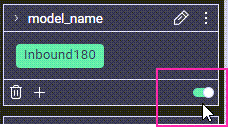
The Filter is OFF if it is grayed out.
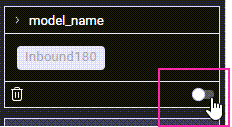
The toggle switch turns the filter ON or OFF. (This allows you to disable a Filter without deleting it.)
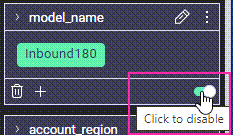
Updating on Every Change
When this option is on, any changes you make to the dashboard filters are updated immediately, and the dashboard is refreshed to reflect the changes.

Best Practice: Keep the update on every change button enabled. However, If you are working with large or complex data sets that result in longer refresh times, then switch off this option. Make all your changes, and click the Update button when you are ready to update your dashboard
Modifying a Filter
- To edit a Filter, hover over the pencil icon on the Filter Title. Select the pencil and an Edit Filter dialog box will appear.
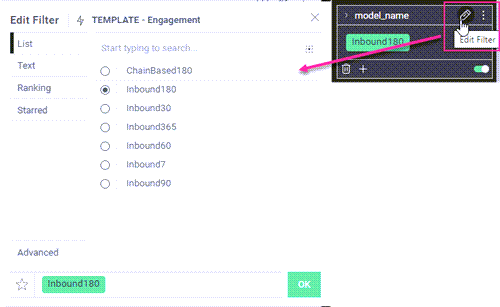
- Toggle the radio dial to the selection you prefer and click OK:
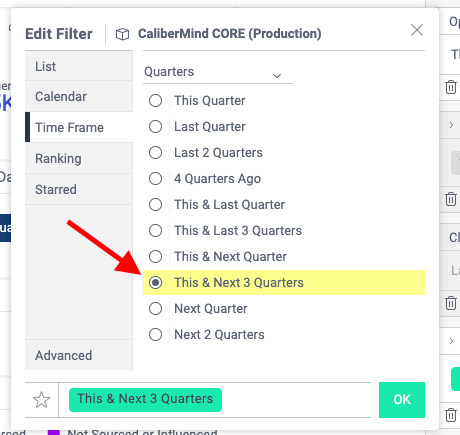
- If you don't see the value you'd like to use, Date Filters allow you to change the aggregate of time:

Much like Salesforce, you can also specify a custom time period by selecting Calendar:
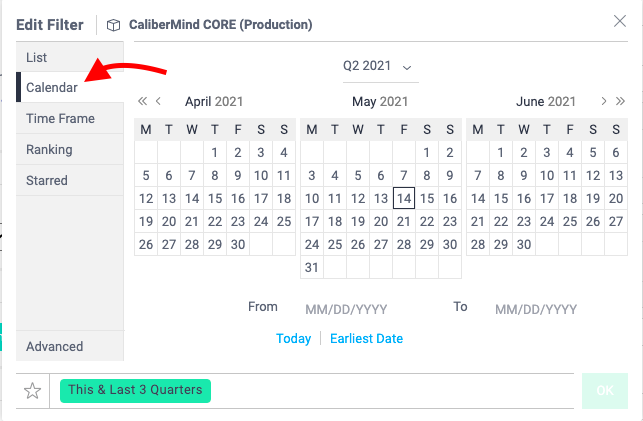
- You may also choose to only view the top X quarters, months, or years filtered by a value (such as Opportunity Dim Amount to see your most productive quarters):
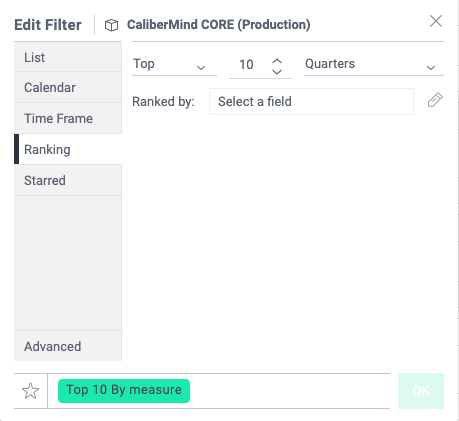
Modifying a Text Filter
- To modify a Text Filter, hover over the Filter and select the pencil or edit icon:
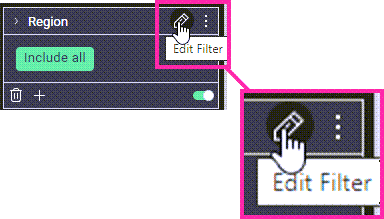
- Select the items you want to include or deselect the items you want to exclude, then click OK:
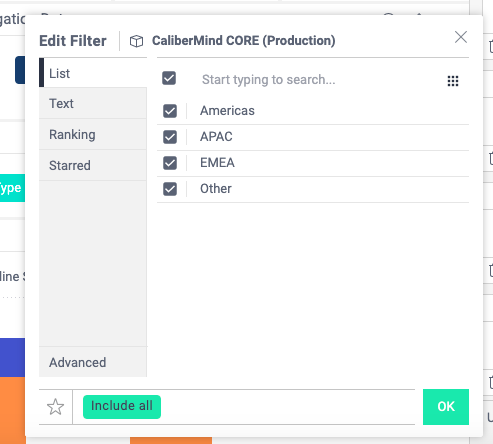
- You may also want to select the Text option to apply text-based logic (such as Containing "America" to filter for North, Central, and South Americas) for Text Filters:
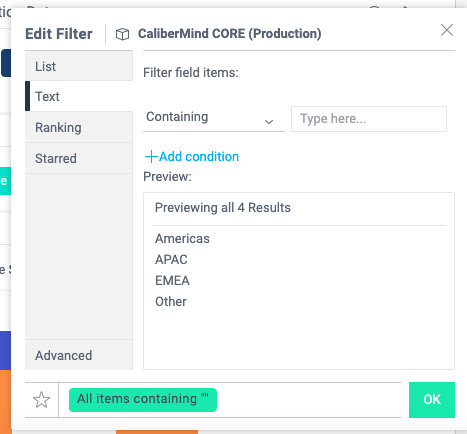
Saving Default Filter Settings
Do you find yourself updating Filters to the same set of values often? You can save your Filters as your Default Filters so your Filters remain the same after you navigate away from your Dashboard. This will save the existing Filters, their configuration, and the order in which they appear in the Filters panel.
- To save your current set of filters as My Default Filters, click the three vertical ellipses at the top right-hand corner of the Filters tab on the dashboard and select Set as My Default Filters:
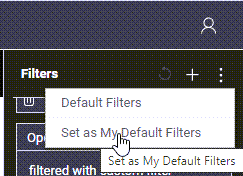
Restoring (Clearing) Filters
To restore your Filters, click the Restore icon next to the Filters menu:

Adding a New Filter
- To add a new Filter, select the plus icon on the Filter section of your Dashboard:
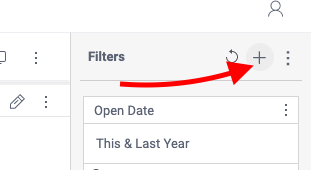
- Search for your Field (Note: We highly recommend reviewing our data schema //coming soon// prior to adding Filters.):
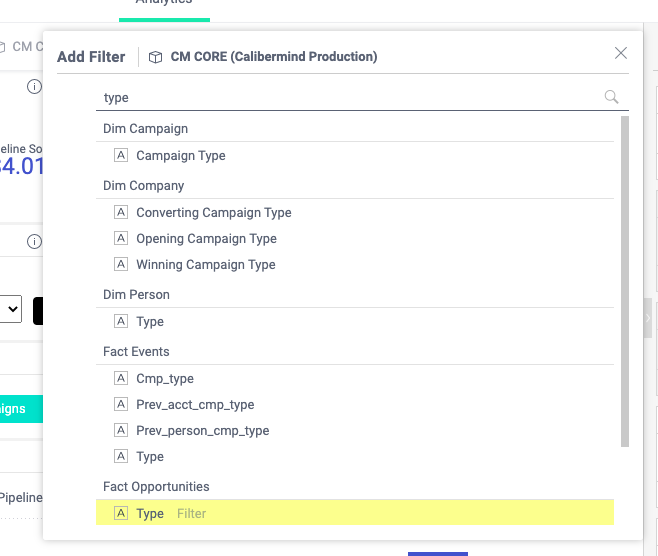
- Choose the values and click Save:

Common use cases include adding a Region Filter to a cloned Dashboard so your Viewers don't have to make changes when they look at their specific region, or you may want to filter your campaign attribution dashboard by Net New Opportunity Type and create duplicate dashboards for Renewals and Expansion business by using Opportunity Type Filters and setting Default Filters.
Locking Filters
If you find a Filter must be set a certain way to make a Dashboard display effectively, you may lock the Dashboard Filter by clicking on the three vertical ellipses and selecting Lock:
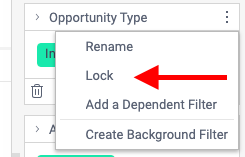
Add a Dependent Filter
A Dependent Filter can be added to an existing Filter to help people further narrow their selection automatically. You can navigate to Dependent Filter by clicking on the vertical ellipses on the Filter you would like to add a dimension to:
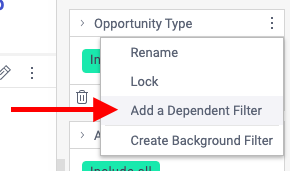
There are several possible use cases for this handy feature. For example, Dependent Filters are great for narrowing down State choices or Territories if your regional manager wants to do this quickly.
If you have a subregion in the North America region, adding a state Dependent Filter to your subregion Filter would help the West Coast regional manager select his subregion and then Filter by applicable states.
If you have a subregion in the North America region, adding a territory Dependent Filter to your subregion Filter would help the West Coast regional manager select a specific representative quickly.
Background Filters
A Background Filter helps Designers limit their Viewer's options when selecting values. You can navigate to Background Filter by clicking on the vertical ellipses on the Filter you would like to limit:
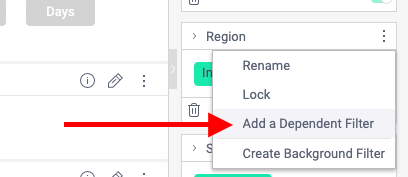
A common use case is excluding the Campaign Type "Marketing Operations" from the Attribution Dashboards by adding a Background Filter. Once the Filter is applied, users can pick and choose any campaign type except the "Marketing Operations" type.
Existing Filter Definitions
This is a list of the default Filters available in our Dashboard templates. For more filter options, check out our Data Schema (coming soon).
Account Tier: A normalized alphabetized tier based on your organization's criteria.
Account Type: Your Account CRM field by the same (or similar) name.
Attribution Eligible: This is a locked filter that only allows campaign values to be considered that are eligible for attribution.
Campaign Name: Based on the Name field in your CRM's Campaign object.
Campaign Type: Based on the field of the same (or similar) name in your CRM on the Campaign object.
Channel Name: This is the channel (think UTM Medium) that a campaign is sourced from, and is often calculated by the UTM parameters collected during our Web Tracking or form fill analysis.
Close Date: Opportunity close date. The corresponding filter will only appear as "On" if you have selected the Closed Date Aggregation Type (see above) on the Attribution Summary dashboard.
Company ID: This is the full ID string from your CRM for your Account object. We recommend either turning this Filter off and using the Account Name filter on the same dashboard or navigating to the Account Detail from a Summary or Overview dashboard by clicking on the name in a Widget.
Company Name: Your CRM's Account Name field.
Engagement Tier: The Engagement Tier will display the normalized aggregate value for account by engagement score as defined by your team. This will use the Engagement Model selected for your organization in the CaliberMind Settings.
Event ID: This is the full ID string for this activity record, which may be a Campaign Member, Event, Task, or other object. We recommend either turning this Filter off and using the Event Name filter on the same dashboard or navigating to the Event Detail from a Summary or Overview dashboard by clicking on the Event name in a widget.
Industry Type: A normalized aggregate based on your industry Field. As an example, Computers & Hardware, Software as a Service, and Information Technology may all be grouped under "Information Technology."
IsWon: This is checked if the opportunity is in a Closed Won status and a handy Filter to use if you want to do a Closed Won opportunity analysis.
Name (Person Engagement Dashboard Only): The Name Field value of your Contact/Lead object in your CRM.
Open Date: Opportunity Created Date. The corresponding filter will only appear as "On" if you have selected the Open Date Aggregation Type (see above) on the Attribution Summary Dashboard.
Opportunity Type: Based on your CRM Opportunity field by the same (or similar) name.
Owner: The current account owner (not the opportunity owner unless a designer has changed the default for your organization).
Program Name: Program categories are defined by your organization during implementation and typically (but not always) are based on the Campaign Parent.
Region: This is based on your CRM region field and is filtered by the account associated with a given opportunity.
Segment: This is a normalized aggregate value based on the number of employees at a given account or as otherwise defined by your team during your implementation.
Title (Person Engagement Dashboards Only): The normalized title of contacts.
Type (Person Engagement Dashboard Only): The Contact object Type field value from your CRM.
